Skype: neodalle-travel
Tel: +86 135 7447 2266
E-mail: sales@visitaroundchina.com
What to see ?
With an area of 13,390 square meters, the main buildings were erected on a traditional north-south axis. The secondary buildings are equally distributed on the east and west sides of this axis. This symmetrical arrangement is a perfect example of traditional Ming Dynasty architecture.
The Screen Wall
The front of the temple is on the south side where there is a screen wall with a height of 10 meters, and an iron flagpole weighing more than 10 tons. The wall is engraved with an auspicious Chinese design of ‘carps jumping over the dragon gate’. Passing through a magnificent wooden archway with delicate carvings of dragons, phoenixes, and ‘lions playing with silk balls,’ one arrives at the main gate of the temple. This gate, with a height of 15 meters, looks mighty and solemn. Being supported by ten pillars but with no beam, the roof is decorated with a pattern of Eight Diagrams.
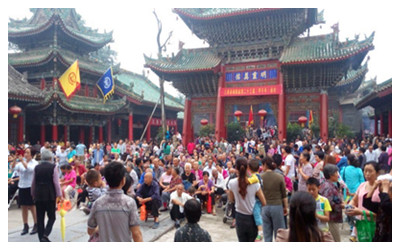
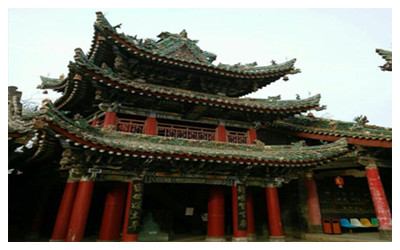 Lingxing Gate
Lingxing Gate
A flagstone path extends north from the gate. There are long galleries on both sides of the path, showing lots of stone steles with calligraphy masterpieces of celebrities of ancient China. Walking north through a wooden arch and then a stone arch, you will arrive at the Lingxing Gate, the entrance to the central courtyard, which shows the essence of this temple.Constructed in 1757, Lingxing Gate is actually a two-storey tower with a height of 13 meters. The north side of the second floor serves as a stage. It was here that many Chinese traditional opera were performed. Nowadays, visitors still have chance to watch some folk performances, such as singing opera and juggling acrobatics during the Mid-Autumn Festival. The west and east veranda of the central yard are exhibition halls which display cultural relics of Tang Dynasty and porcelains of Ming and Qing Dynasties.
Bell & Drum Towers
A bell tower and a drum tower stand symmetrically on the east and west sides of the central courtyard. Both are 17.5 meters tall and each has 12 pillars in order to bear the weight of their roofs. There is a 3 meters high bell on the second floor of the bell tower. There is also a 1.5 meters diameter drum on the second floor of the drum tower.
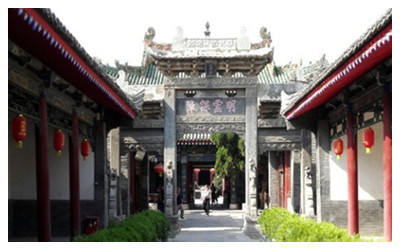
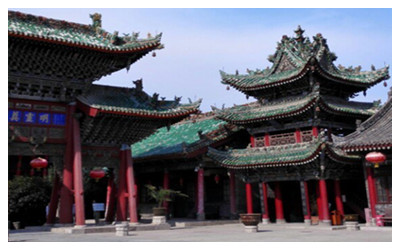
Temple Archway
In the center of this courtyard stands a spectacular archway, which is the biggest in the whole temple. The design of the top of the arch is brilliant and creative. Abundant carvings add to the beauty of this arch and many depict scenes from famous Chinese legends, such as “Nu Wa Mends the Sky” and “The Eight Fairies”. The top of this archway is engraved with 58 images of little boys with expressions and gestures that are vivid and distinctive.
City God Palace
In the north of the courtyard and facing the arch, there lies the City God Palace, the main palace of the temple. With an area of 837 square yards (700 square meters), this palace consists of the Worship Palace and the Sacrifice Palace from south to north. In the Worship Palace, there are 20 temple paintings which describe Yama and the deepest reaches of hell. The main subjects of these paintings are figures, animals, birds, flowers, palaces, weapons, tools of torture and monsters. The records show that there are 711 of these images in total. The artistic skill and of strong colors used in these paintings emphasize the gruesome and mysterious atmosphere they depict. The Sacrifice Palace is dedicated to a large statue of Li Jing accompanied by four statues of Buddha’s guardians. In ancient China, temples were built during most dynasties to commemorate major events or for the worship of local heroes. The City God, a deity in Daoist mythology, oversees the affairs of the city. The ancient Chinese built a City God Temple in order to seek protection from their chosen deified hero. In this way, the local people in Sanyuan built this temple to pray to Li Jing for happiness and peace.
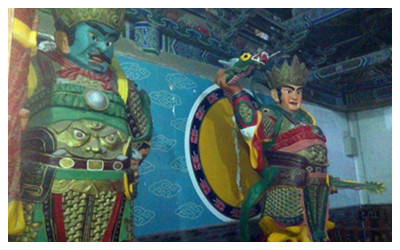
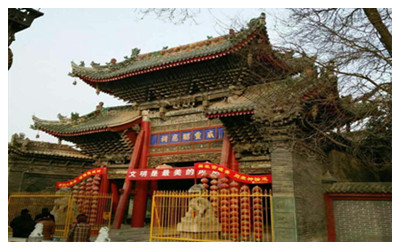
In the northernmost part of this temple is the Living Palace. This palace covers 833 square yards (697 square meters) with the walls decorated with carved wooden windows. There are some exhibits in this palace that are mainly wooden, stone or copper religious statues of Ming and Qing Dynasties, carved artworks and many other folk handicrafts.
Travel Tips
Entrance Fee: CNY42
Opening Hours: 08:00-17:30
How to get there: You can take regular bus to Sanyuan County from Xian North Passenger Transport Station or Xian Long-Distance Bus Station.
You can go to Sanyuan by train from Xian Railway Station.
After arriving at Sanyuan, take a taxi direct to the City God Temple
 Ask Questions ?
Ask Questions ?